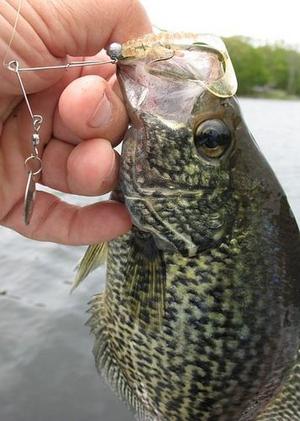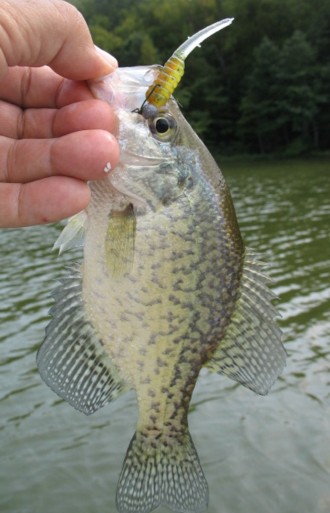
SpoonMinnow
TU Member-
Posts
141 -
Joined
-
Last visited
-
Days Won
9
SpoonMinnow last won the day on March 4
SpoonMinnow had the most liked content!
About SpoonMinnow
- Birthday 05/09/1949
Profile Information
-
Location
Walden, NY
-
Interests
Finding unique lure shapes and actions that catch all kinds of fish
SpoonMinnow's Achievements
-
As far as snags go, consider going lighter when it comes to jigs. A 1/16 oz jig will do as well if not better than a 1/8 oz. Examples of grub bodies joined using a flame to melt grub bodies together: Some shapes were from molds that I pour. One other I discovered last year when the curl tail was bit off. That day it caught all kinds and size fish! Who knew that mini-sticks and grub bodes minus action tails would do so well ?! Even Sassy Shad grubs did better with the tail cut off and the body made slimmer by cutting off the belly.
-
SpoonMinnow started following Been a banner year testing new shapes and actions , New to pouring soft plastics , Cut tail worm and 6 others
-
As far as rerigging plastics, you might consider using this what I call the Grub Grip that I use it on all my jig heads. It's nothing more than coated 24g wire used for floral arrangements and is sold at Walmart or on-line. Follow the steps and you'll never want to use jigs with collars that damage lure when changing them. Cut a small piece and line it up. Wrap one side tight under the line tie and cut one side close: Bend the wire: The wire swings into the grub body as so: The wire is great for plastic trailers which allows them better action than threading them up the hook: If I must buy a collared jig for a specific weight and hook size, I crush the collar and cut it off with wire cutters. It takes less than a minuted to add the gripper. For tiny jigs (1/32 and 1/64 oz) I use a smaller gauge wire.
-
Kut Tail with a K is the spelling. The design is superior to the usual plastic worm design as well as of the plastic mix used. The worm is tapered to a thin tail; the plastic and additive used makes the worm heavier yet flexible at the middle of the lure. The special shape of the tail acts as a rudder that works well with the shape and plastic consistency which I have a felling is close to that of a Senko. One presentation that kicks you-know-what is the use of a light jighead (1/16 oz, 1/24 oz) with 1/0 hook. It has an increbible action as a jerk worm, zigging & zagging, whip-like, in water 10' or less and especially near or over vegetation. Pauses allow the lure to drop a bit before adding more action with the rod tip. I've also add a grub body to the front of the worm via the candle flame method of fusing the parts of soft plastics together. The Kut Tail catches EVERYTHING! in all sizes!
-
After a fish bit off the curl tail, I fished just the body and was shocked how many fish were caught on it. (note the chartreuse body's color was altered using markers.) Then I started to fool around with different mini-stick shapes that did just as well: Doesn't take much rod tip/reel handle action and a child could catch fish with them. Something to think about when it comes to simple baits that catch fish and fishermen.
-
Last summer I brought along some beetle spins just for the hell of it and add different soft plastics to see which caught fish. Dang if it didn't get slammed by different fish species. Ribbon Tail worm: Thin flat tail (Mo Magic mold) Crappie Magnet tail Whopper Stopper Worm and other worm If anyone wanted to make and sell the wire forms with or with out jigs, would that be a patent infringement?
-
M-F has been a supplier of my favorite plastic in different grades for 20yrs. When a good product become unavailable, for whatever reason, I watch for its return. A popular company that has supplied thousands of gallons over many years should be given a break -no questions asked. When a good company + products is back up - for whatever reason sevice was suspended - I'm ready to resume ordering and relieved that I can. There is a need to stay with what fulfills one's needs and M-F has always done that for me. Bad companies on the other hand, due to inconsistent quality either in service or product, I will not recommend and in fact will warn others about MY expericences. Two strikes and they're out! To each his own. No argument necessary.
-
Sad that those that lack imagination cast aspersions on those that do have it, having little else to offer. Incredible is the simple fact that many Frankenstein soft plastics do far better than what you pay for and are the ultimate in finesse design. In fact, some shapes/actions have been borrowed from existing conventional lures , many of which are uniquely different and do very well for many fish species. My obsession with new designs reflects on a few things: 1. Good lure action-profiles + size can make all the difference when it comes to sizes of fish caught and quality within the number. 2. Hard or soft plastic lure design in general can be categorized by how lures move when retrieved. Crankbaits are different than spinnerbaits; bass jigs and trailer display motions different tha both. So, when to comes to soft plastics, the concept of categories applies based on shape and action. Again, it's difficult to explain to anyone lacking an imagination or an open mind the subtle differences in design - like for any lure type - that make a lure superior and more strike-provocative. Good thing Dave posts relative comments that encourage the sharing of ideas unlike others that have little to offer.
-
The only problem I see using scent is that it takes a while for it to diffuse into the water whether the lure is still or moving and even less when it is oil based. Attacking a lure and holding on longer are claims scent advocates insist are factual and maybe so for vertical presentations, but in my case I always cast and retrieve horizontally to cover water. My shapes and action designs are the only thing I have confidence in even at the slowest retrieve.
-
I call that design a spike/stinger tail and love it - except smaller. The tail quivers with the least motion and whips back & forth with more action imparted. The lure you posted I'd rig on a 1/16 oz ball head jig with 2/0 or larger hook.
-
Realism and natural-looking are overrated in my book. Long ago I targeted bass when I fished tournaments and used typical bass lures such as Texas rigged 10" worms always with curl tail, spinnerbaits with different sizes and shaped blades, jigs with pork trailers (UJ Frog), deep dive crankbaits and many different surface and shallow running lures. Lesson learned after catching bass on all of them: lures don't convince fish a lure is a real live animal but rather hit their senses where it counts by turning on the attack mode in its simple brain. example: 2 lb bass in my pond lay on the bottom near when I stand on my dock because I fed them live yellow perch, 4" or larger that were caught in another lake. 20 sunnies attack bits of bread over them. So I thought, why not chuck a large piece of bread and see what the bass would do. Sure enough one attacked it but then spit it out because bass don't eat bread. Size mattered! A strip of bread has no action on the surface but neither does a dead yellow perch as it floats. Could be the bass thought it was just another fish to eat same as the crappie and white perch I fed them last week. Getting back to flat sided lures. The bread and the fish that fish eat have flat sides; worms and leeches are round - BUT SO WHAT!?? My thing is to find what sets off a fish's aggression trigger regardless how weird and unnatural (preferable at times) a lure looks and acts. I will never refer to my lures as minnows, frogs or crawdads. Fish don't / can't. When it comes to French Fry stick body segments attached to various action tails, the ribbed sides are texured and various tail shapes determines what the body does - as usual. I value the lures pictured and have a great deal of confidence in them because of the many fish and fish species they caught. Others have used my lures and did well. So, regardless of what belief you or I hold as the reason fish strike lures, where and how fish are caught are at the top of the list.
-
-
IMO - no. How you present a lure - any lure - what it's rigged on and the retrieve, are the only considerations in my book. Fish generally aren't in a feeding frenzy and lures provoke aggression from neutral fish. Worms or soft sticks and other soft plastics, unlike spinnerbaits and crankbaits, are designed for a slow irregular retrieve that fish get a good look at before striking. Talk about flat sides. The French Fry with its four, flat sides is just as effective as a round or semi-round stick. I attach French Fry segments to various tails which get bit by many species of fish. Round or semi round grubs or worms are overrated in my book. As far as natural looking, how many lures that you've caught fish on were natural in shape or action. I stopped pretending years ago that it mattered and now strictly focus on whatever it is about a lure that caught fish - action and shape.
-
Catfish, carp and other bottom munchers are the only fish that take the time to sample the vittles - meaning: slowing mouthing the objects they decide worth the trouble to eat. I do just fine with no scent even after Coppertone might have gotten on the lure. All the lures I fish cover water - some faster some slower but none stationary to allow manmade molecules to diffuse into tiny nostrils or taste testing. JMHO based on approx. 50 yrs. experience catching so many fish on unnatural objects)
-
Sticks are sticks regardless of flat or full round. I've caught fish on both regardless of size though I prefer a full found for the slight side-to-side roll when retrieved - especially when it come to laminate colors. Medium hardness is all I use and still get the darting back & forth action needed to whip or twitch lures, durability not really the issue. When it comes to silicone one-sided vs metal injection molds, I paint the silicone cavity with Fish Formula for a more shiny finish. Fish IMO aren't fussy when it comes to the many favorites I cast which I've posted on many forums. It's just a matter of - will they also attack this or that? Variety in my book is the spice and challenge of fishing. No more dull live bait that sits in one spot trying to be appealing. Bring on the quivering, thumping, whipping, flapping actions that tickle the lateral line and cause the most irritation when trespassing a fish's space/ privacy. Action - shape - size - color brightness: the only considerations in my book when it comes to annoying subsurface objects that fish have the need (but no imagination) to show who's boss. Thank the Lord there are so many combinations to chose from that allow me to pretend were the best (though fickle) choices able to catch so many fish on any one day. Yours truly
-
Stick baits first made the scene with the Senko which introduced the wacky rig. I found other the stick shape amazing when used as a jerk bait. This white perch and 4 other fish species have pounded it in the last month. It was made using part of a plastic stick from a mold and rigging it on a light jig. With a combination of rod twitches and reel handle turns, the lure quivers and/or darts. I've had fish strike it 4x on the same retrieve and fish I missed slam it off the bottom. Soft plastic was used to get the best finesse action. The other suprise this year was a stick in the shape of a carrot. Same type of action except smaller in size. 5 colors did well.
- 1 reply
-
- 2
-




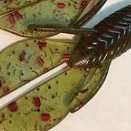















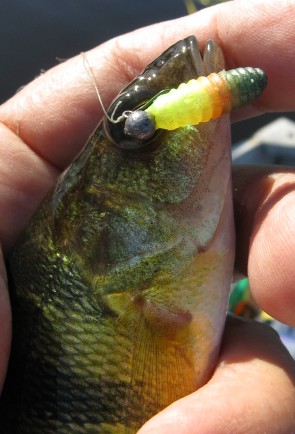


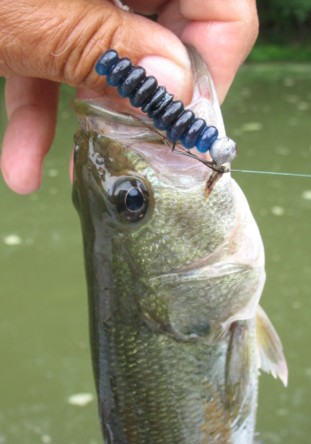
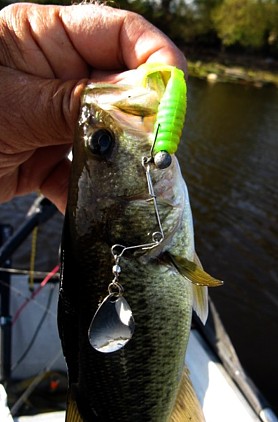
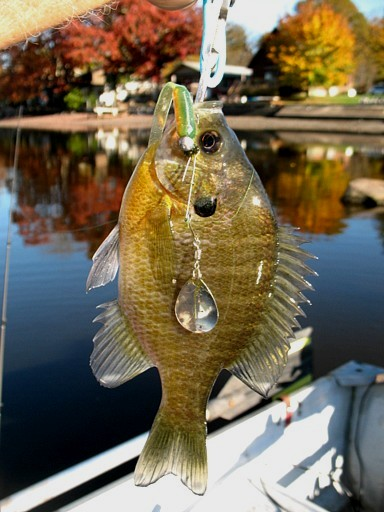

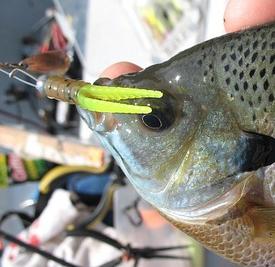


.jpg.f24fab6fa07a9fb25f37c420f89cefaa.jpg)
